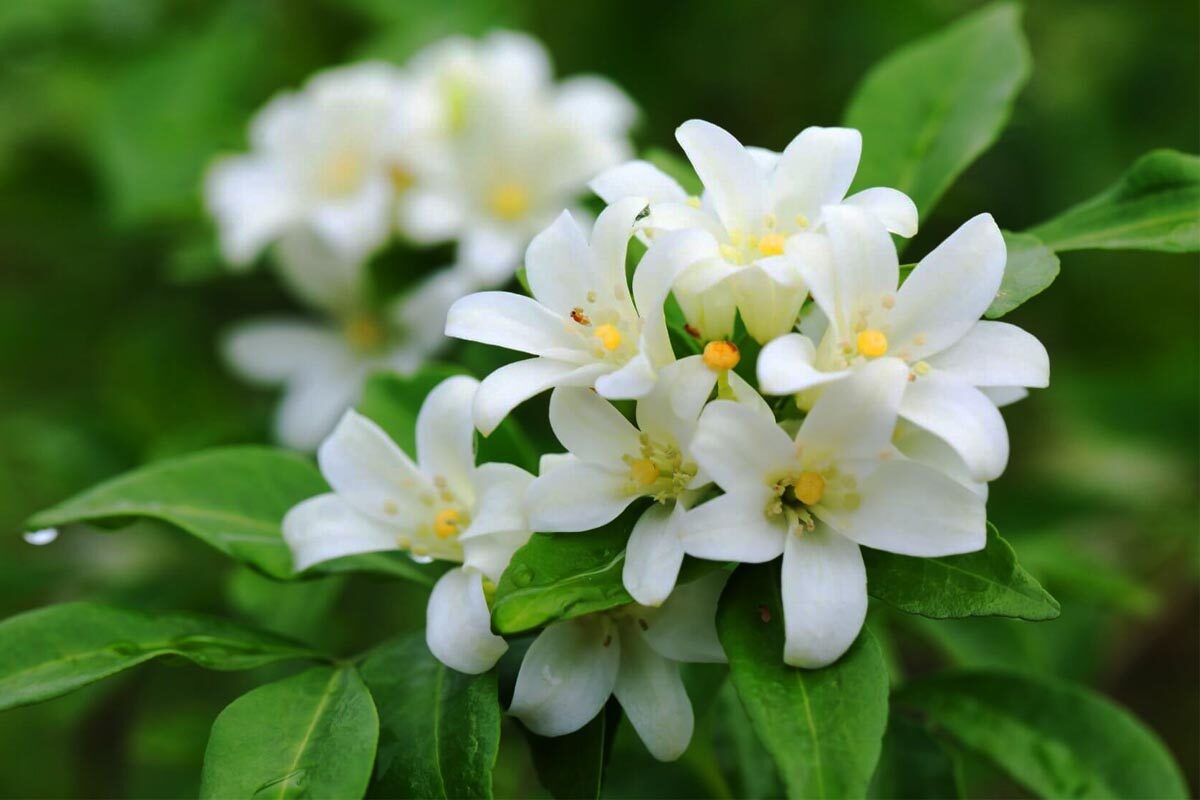
Introduction to Jasmines
- Botanical Name: Jasminum species
- Common Varieties:
- Jasminum sambac (Mogra)
- Jasminum auriculatum (Jui)
- Jasminum grandiflorum (Jai)
- Jasminum officinale (Chameli)
- Jasminum pubescens (Kunda)
Family: Oleaceae
Jasmines are widely cultivated for their fragrant, white flowers, which are used in making garlands (Veni), floral decorations, and essential oils. Among various species, Mogra (Jasminum sambac) has high commercial value due to its strong fragrance.
Importance of Jasmines
- Jasmine flowers are highly prized for their sweet fragrance, making them essential in the production of garlands (Veni), floral decorations, and attars (essential oils) for perfumes.
- Mogra (Jasminum sambac) is the most commercially important variety due to its intense fragrance.
Soil and Climate Requirements
- Soil: Jasmines require well-drained, porous, and fertile soil. The soil should be rich in organic matter to support healthy plant growth.
- pH: Ideal pH range is 6-7 for optimum growth.
- Climate:
- Jasmines prefer a hot and dry climate for better yield.
- They are sensitive to waterlogging and need good drainage for healthy roots.
Jasmine Varieties
- Mogra: Common varieties include: Motia, Madanban, Ramban, Bela, Virupakshi, Rai.
- Jui (Jasminum auriculatum): Varieties: Co-1, Mullai, Parimuiii, Large Round, Short Point.
- Chameli or Jai (Jasminum grandiflorum): Varieties: Co-1, Coimbatore, Pink Pin.
- Kunda (Jasminum pubescens): Known for its unique fragrance.
Propagation of Jasmines
- Cuttings: Jasmines are primarily propagated through cuttings of almost mature wood. This is the most common and successful method of propagation.
- Layering: Layering can also be used to propagate jasmines.
- The best time for propagation is during the rainy season, when the conditions are most favorable for rooting.
Planting of Jasmines
- Land Preparation: Thorough land preparation is essential, with proper addition of organic manures.
- Planting Season: Planting is usually done during the rainy season to ensure good establishment.
- Planting Distance:
- Mogra: 75 cm x 1 m.
- Jui: 1.8 m x 1.8 m.
- Chameli (Jai): 1.8 m x 1.8 m.
Irrigation Management
- Initial Irrigation: During the establishment phase, irrigation should be given at an interval of 3-4 days if there is no rainfall.
- Subsequent Irrigation: Once the plants are established, irrigation can be reduced to once every 15 days.
- Watering Method: Ensure proper drainage to avoid waterlogging, which can damage roots.
Nutrient Requirements
- FYM (Farm Yard Manure): 15 tons per hectare is recommended to provide essential organic matter.
- Fertilization: Apply 100:50:50 kg NPK per hectare in split doses:
- First dose: During pruning, usually in January–February.
- Second dose: During flower bud formation in March.
This balanced nutrient management promotes healthy growth and flowering.
Special Cultural Practices
i) Bahar Treatment:
- Essential for ensuring high-quality flowering in jasmines.
- Water withholding for 40-50 days prior to flowering induces dormancy, helping the plant to shed leaves and rest.
- This treatment is usually done in November–December.
- After leaf shedding, irrigation is resumed in January–February, triggering flowering.
ii) Pruning:
- Regular pruning is crucial, especially for Mogra, as it encourages new growth and better flower production.
- Pruning is usually done after 2 years of planting and is carried out in January–February.
- The pruning height is generally 45–50 cm from the ground.
Harvesting of Jasmine Flowers
- First-Year Flowering: Jasmine plants start flowering from the first year of planting, but commercial yield begins after the second year.
- Flower Picking:
- Mogra flowers are picked early in the morning when they are still in the unopened bud stage.
- For Gajara and Veni, buds are picked just before they fully open.
- For attar oil production, fully opened flowers are harvested.
Post-Harvest Management: Mogra has a very short post-harvest life and needs to be transported within 2-3 hours of picking to ensure freshness.
Yield of Jasmine Flowers
- Mogra (Jasminum sambac): 10-12 tons per hectare.
- Jui (Jasminum auriculatum) & Jai (Jasminum grandiflorum): 3-4 tons per hectare.
- Kunda (Jasminum pubescens): 5-6 tons per hectare.
These yields vary based on climate, soil quality, and cultivation practices.

